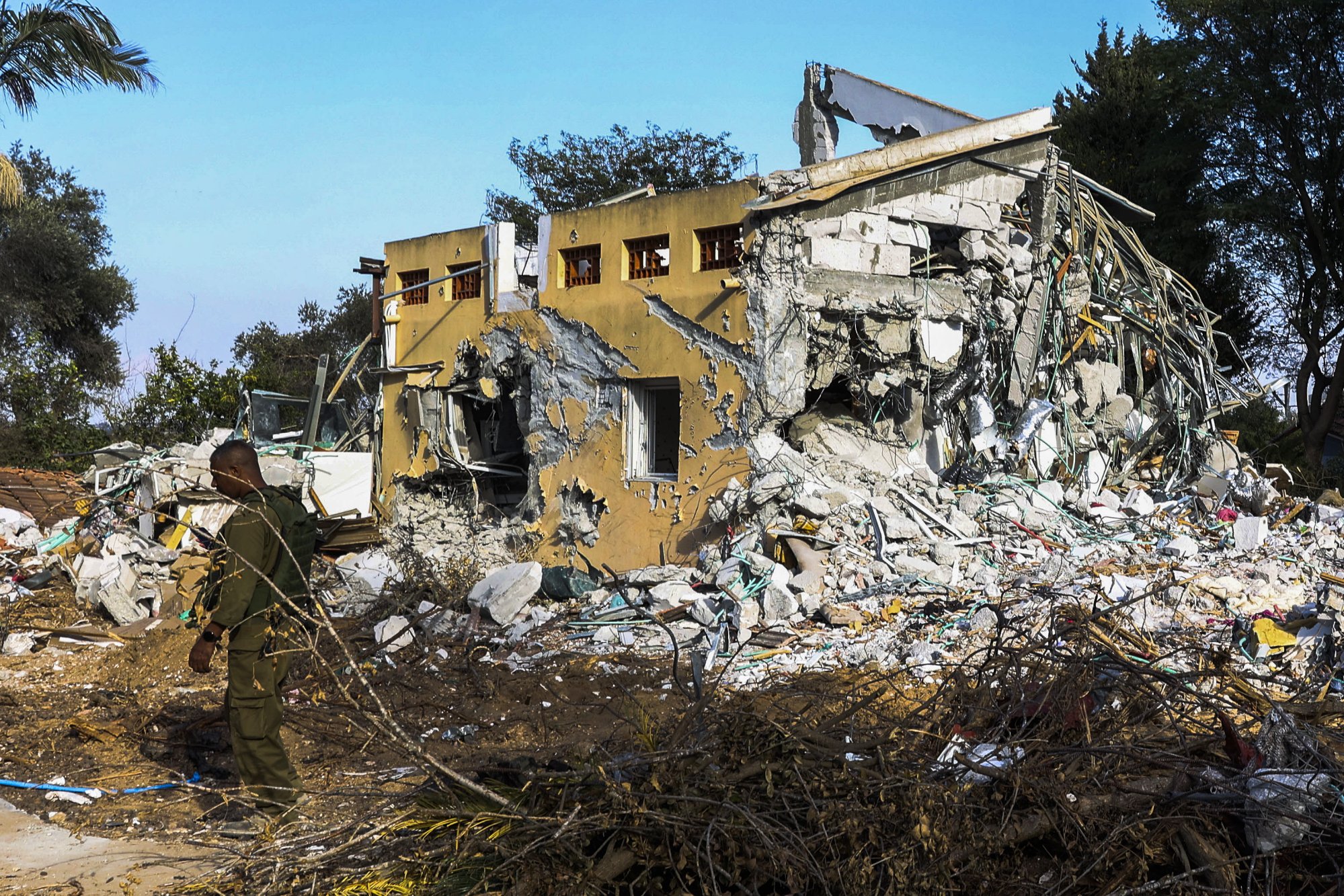
A woman, whose mother and niece were killed in Hamas’ attack on October 7, cries in the burned-out remains of her mother’s home in Kibbutz Nir Oz, in southern Israel, on October 30. Three members of the family - two children and their father - were kidnapped. Photo: Reuters
Israel-Gaza war: don’t rewrite the past and ignore Hamas’ brutality
The restrictions on Gaza did not give rise to the violence; it was violence that made the restrictions necessary in the first place. The first step to a better future is getting history right and freeing the Gaza Strip of Hamas control.
History is back-to-front for those who seek to justify Hamas’ terrorism. The restrictions on Gaza did not give rise to the violence; it was violence that made the restrictions necessary in the first place.
Some might seek to justify Hamas’ brutality as a response to the lack of progress in negotiating a political solution between Israel and the Palestinians. However, the 1988 Hamas charter calls for the total annihilation of the state of Israel and instead establishing a fundamentalist Islamic state.
Hamas embraces holy war, or jihad, to destroy any people who do not believe in its religious cult. Like Islamic State, Hamas doesn’t believe in political solutions but rather the death of others as a way to fulfil its political and religious goals. The brutality of its atrocities in Israel on October 7 – when 1,200 Israelis were slaughtered, burned alive and tortured to death and 238 others were abducted as hostages – is a reflection of that.
Israel withdrew from Gaza in 2005, uprooting its 8,000 citizens who lived there. Israeli citizens in Gaza lost their homes and schools, and they carried their cemetries with them. They left behind only the Israeli greenhouses in the hope that these would support the Palestinian agriculture sector.
 A destroyed house at Be’eri Kibbutz in Israel, which was attacked by Hamas on October 7.
A destroyed house at Be’eri Kibbutz in Israel, which was attacked by Hamas on October 7.
While the withdrawal was unilateral, at the time, Israel and the Palestinian Authority signed an agreement on movement and access. This included the establishment of an international crossing on the Gaza-Egypt border. The crossing was controlled by the Palestinian Authority, under the supervision of monitors from the European Union. During the 19 months in which the crossing point was in operation, it was used by nearly 450,000 people, or about 1,500 a day.

But Hamas took control in 2007 and violently eliminated the Palestinian Authority’s presence in Gaza. The European monitors, fearful for their safety, fled and the crossing arrangements collapsed.
The agreement on movement and access also included provisions for the construction of a seaport and airport, as well as arrangements for transit between Gaza and the West Bank. These were all frustrated by Hamas’ violence and rejection of any arrangements coordinated with Israel.
This was not the first time that the movement of the residents of Gaza was sabotaged by Palestinian violence. Under previous agreements with Israel, an international airport operated in Gaza between 1998 and 2001. It was opened in the presence of then-US President Bill Clinton and operated flights to destinations including Egypt, Jordan, Syria and Saudi Arabia but the violent outbreak of the second intifada led to its closure.
Similarly, negotiations for a port in Gaza were undercut by instances of arms smuggling through the sea, including an attempt to bring in 50 tonnes of weapons in the vessel Karine A. The Palestinian fishing industry also paid the price for this continual smuggling, which resulted in a reduction in the Palestinian fishing zone which had reached up to 20 nautical miles from the shore.
Egypt has also recognised the need to impose border constraints to prevent the smuggling of arms. Even President Mahmoud Abbas of the Palestinian Authority spoke out in favour of the Egyptian restrictions to prevent arms reaching Hamas in Gaza.
Israel has made great efforts over the years to ease the humanitarian impact of the restrictions. In 2010, it adopted a new policy of allowing all goods into Gaza, provided that they were strictly civilian, while limiting “dual use” items that could be used for terrorist activity. It also allowed the resumption of agricultural exports.
In the months before October 7, Israel continued its efforts to alleviate economic and humanitarian hardship. Some 18,000 Gazans received permits that enabled them to enter Israel for work every day, and hundreds of Gazans in need of medical treatment were admitted to Israeli hospitals.
Some of those permitted to enter for work are suspected to have provided intelligence to Hamas, assisting in planning its massacres. Additionally, among the Israelis killed or kidnapped by Hamas were several of the volunteers who ferried Palestinian patients from the border to their hospital treatments in Israel.
Far from being motivated by humanitarian hardship, Hamas perpetuates it. In 2021, the pro-Hamas outlet Al Mayadeen reported that the organisation had refused offers for a complete lifting of all restrictions in return for a cessation of hostilities with Israel.
In previous rounds of violence, Hamas has directed attacks not only at Israel but also at the crossing points which are the lifeline of aid to Palestinians. In the earliest stages of the current war, both the Kerem Shalom and Erez crossing points were put out of action by Hamas rocket fire.
The confusion of cause and effect that creates this backwards history is at work in the criticism of Israel’s defence today. Military operations in civilian areas or limitations on the entry of fuel can only be understood once Hamas entrenchment in those areas and the theft and stockpiling of Gazan fuel is recognised.
Hamas is a terrorist organisation whose main cause is to destroy the state of Israel. To fulfil this cause, it is willing to sacrifice the population of the Gaza Strip and use them as human shields, turning them into martyrs for its unholy cause. It does it while most of its leaders live in five-star hotels away from the Gaza Strip.
Rewriting the past will not help the people of Gaza. The first step to a better future is getting the history right, it’s getting the Gaza Strip free of Hamas control.







No comments:
Post a Comment
Note: Only a member of this blog may post a comment.